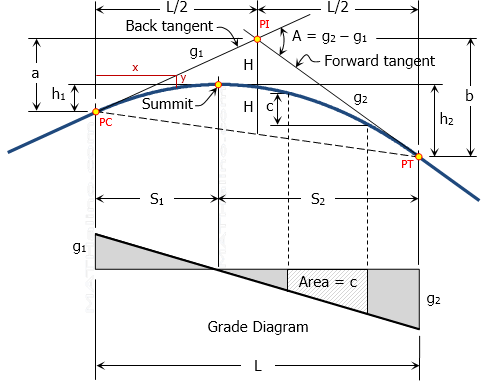Parabolic Curve
Vertical Parabolic Curve
Vertical curves are used to provide gradual change between two adjacent vertical grade lines. The curve used to connect the two adjacent grades is parabola. Parabola offers smooth transition because its second derivative is constant. For a downward parabola with vertex at the origin, the standard equation is
Recall from calculus that the first derivative is the slope of the curve.
The value of y' above is linear, thus the grade diagram (slope diagram) for a summit curve is downward and linear as shown in the figure below. The second derivative is obviously constant
which is interpreted as rate of change of slope. This characteristic made the parabola the desirable curve because it offers constant rate of change of slope.
Elements of Vertical Curve
- PC = point of curvature, also known as BVC (beginning of vertical curve)
- PT = point of tangency, also known as EVC (end of vertical curve)
- PI = point of intersection of the tangents, also called PVI (point of vertical intersection)
- L = length of parabolic curve, it is the projection of the curve onto a horizontal surface which corresponds to the plan distance.
- S1 = horizontal distance from PC to the highest (lowest) point of the summit (sag) curve
- S2 = horizontal distance from PT to the highest (lowest) point of the summit (sag) curve
- h1 = vertical distance between PC and the highest (lowest) point of the summit (sag) curve
- h2 = vertical distance between PT and the highest (lowest) point of the summit (sag) curve
- g1 = grade (in percent) of back tangent (tangent through PC)
- g2 = grade (in percent) of forward tangent (tangent through PT)
- A = change in grade from PC to PT
- a = vertical distance between PC and PI
- b = vertical distance between PT and PI
- H = vertical distance between PI and the curve
Symmetrical Parabolic Curve
In this section, symmetrical parabolic curve does not necessarily mean the curve is symmetrical at L/2, it simply means that the curve is made up of single vertical parabolic curve. Using two or more parabolic curves placed adjacent to each other is called unsymmetrical parabolic curve. The figure shown below is a vertical summit curve. Note that the same elements holds true for vertical sag curve.

Properties of Parabolic Curve and its Grade Diagram
- The length of parabolic curve L is the horizontal distance between PI and PT.
- PI is midway between PC and PT.
- The curve is midway between PI and the midpoint of the chord from PC to PT.
- The vertical distance between any two points on the curve is equal to area under the grade diagram. The vertical distance c = Area.
- The grade of the curve at a specific point is equal to the offset distance in the grade diagram under that point. The grade at point Q is equal to gQ.
Formulas for Symmetrical Parabolic Curve
The figure shown above illustrates the following geometric properties of parabolic curve. Note that the principles and formulas can be applied to both summit and sag curves.
rise = run × slope
$b = \frac{1}{2}g_2L$
Neglecting the sign of g1 and g2
$\dfrac{S_1}{g_1} = \dfrac{L}{g_1 + g_2}$
$\dfrac{S_2}{g_2} = \dfrac{L}{g_1 + g_2}$
vertical distance = area under the grade diagram
$h_2 = \frac{1}{2}g_2S_2$
Other formulas
$\dfrac{x^2}{y} = \dfrac{(\frac{1}{2}L)^2}{H}$
- Log in to post comments
